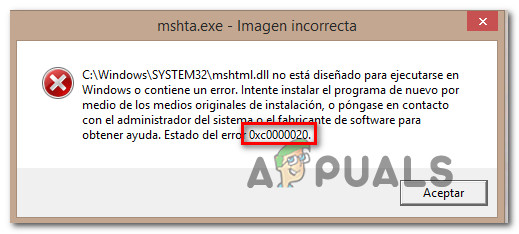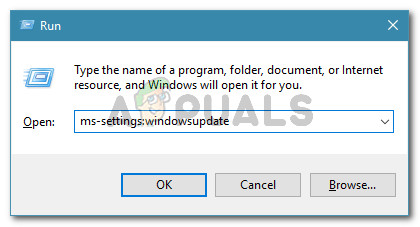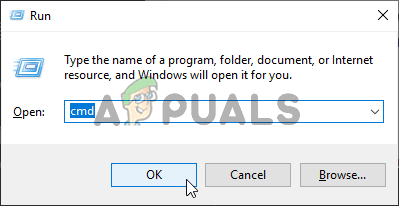How to Fix System Restore Error 0xc0000020 on Windows?
Several Windows 10 users have been reaching us with questions after trying unsuccessfully to use the System Restore function on their PC. Some users are reporting that although they were originally able to start the System Restore utility and pick an appropriate system restore point, the procedure fails with startup error with the 0xc0000020 error code at the next computer startup. However, the are a lot of different variations of the files that are signaled for being responsible

What’s causing the Error code 0xc0000020 on Windows 10?
We investigated this particular issue by looking at various user reports and by testing out the different repair strategies that are recommended by other users that have successfully managed to resolve the issue. As it turns out, several different scenarios might trigger this error message. Here’s a shortlist of potential culprits that might be responsible:
- Outdated Windows 10 build – As it turns out, this particular issue is often occurring in situations where the user hasn’t yet install the Fall Edition update. This update has reportedly patched a System Restore bug that might trigger this sort of behavior. If this scenario is applicable, you should be able to resolve the issue simply by installing every pending Windows update.
- System File Corruption – According to various user reports, one of the most common causes that will spawn the 0xc0000020 error code is system file corruption. In this case, you should be able to resolve the issue by running a couple of utilities capable of resolving logical errors and dealing with corrupted OS files (SFC and DISM).
- Broken OS component – Under certain circumstances, you could be facing a severe corruption issue that cannot be resolved conventionally. In this case, you should be able to resolve the issue by refreshing every OS component (either by a clean install or by performing a repair install).
If you’re encountering this particular issue and some of the scenarios presented above seemed applicable, chances are this article will provide some viable repair strategies. Down below, you’ll find a collection of potential repair strategies that other users in a similar situation have successfully used to get to the bottom of this issue.
If you want to remain as efficient as possible, we advise you to follow the potential fixes below in the same order that we arranged them in. Eventually, you should stumble upon a fix that should resolve the issue regardless of the culprit that’s causing the issue.
Let’s begin!
Method 1: Install every pending update
As it turns out, one particular reason that will cause the 0xc0000020 error code is a glitch that’s still present in Windows 10 builds that haven’t applied the Fall Edition update. Several affected users that have been struggling with this kind of behavior have reported that they finally managed to resolve the issue by installing every pending update on their Windows 10 build.
This is supposedly effective because Microsoft has already released a fix that is aimed at patching a glitch that might be responsible for the apparition of the 0xc0000020 error.
Here’s a quick guide on installing every pending update on your Windows 10 computer:
- Press Windows key + R to open up the Run dialog box. Next, type ‘ms-settings:windowsupdate’ and press Enter to open up the Windows update tab of the Settings app.

Run dialog: ms-settings:windowsupdate - Once you arrive inside the Windows Update screen, move over to the right-hand side panel and click on Check for updates.
- Next, follow the on-screen instructions to install every pending update until you bring your Windows 10 build to the latest.

Checking for updates on Windows 10 Note: If you are prompted to restart before every pending update is installed, restart your computer as instructed, but make sure to return to this screen at the next computer startup to complete the installation of the rest of the pending updates.
- After each pending update is installed, restart your computer once again and see if the issue is resolved at the next computer startup.
If you’re still encountering the 0xc0000020 error code, move down to the next set of instructions below.
Method 2: Running DISM and SFC scans
As it turns out, one of the most common causes that will trigger the 0xc0000020 error code is some type of System File Corruption. Keep in mind that System Restore uses some WU (Windows Update) to revert some Windows components to a previous point in time.
Because of this, several different files might be triggering this type of behavior. According to several affected users, you can resolve the problem in this particular scenario by running a couple of utilities capable of fixing logical errors and system file corruption DISM (Deployment Image Servicing and Management) and SFC (System File Checker).
To be clear, both tools are useful in a situation such a this, but they go about fixing the problem in different ways. SFC is local-only and relies on a cached archive stored inside the Windows folder to replace corrupted items with fresh copies. DISM, on the other hand, uses the WU component to get the healthy copies that it needs for the repairing process.
But because both utilities have their strong-suite, we encourage you to run both to maximize your chances of fixing the system file corruption that’s causing the 0xc0000020 error code. Here’s what you need to do:
- Open up the Run dialog box by pressing Windows key + R. Next, type ‘cmd’ inside the text menu and press Ctrl + Shift + Enter to open up a Command prompt with admin access. When you’re prompted by the UAC (User Account Control), click Yes o grant administrative privileges.

Running Command Prompt - Once you’re inside the elevated CMD window, type the following command and press ENter to initiate a DISM scan:
Dism.exe /online /cleanup-image /scanhealth Dism.exe /online /cleanup-image /restorehealth
Note: Before you initiate this procedure, keep in mind that the DISM utility needs a reliable internet connection to download healthy copies to replace the corrupted files that are causing the issues. The first command (scanhealth) is used to scan and look for system file inconsistencies, while the second command (restorehealth) is used to replace inconsistencies found by the first scan.
- Once the DISM scan is complete, restart your computer and wait for the next system startup to complete.
- After the next PC startup sequence is complete, follow step 1 again to open up another elevated command prompt, then type the following command and press Enter to initiate an SFC scan:
sfc /scannow
Note: After you start this SFC scan, do not interrupt it before the process is complete. Doing this might leave your system exposed to other logical errors that might create further issues.
- Restart your computer once again and repeat the action that was previously triggering the 0xc0000020 error code.
If you’re still encountering the same problem, move down to the next method below.
Method 3: Perform a repair install
if you’ve followed all the potential fixes above and you’re still encountering the same type of error, you’re likely dealing with an underlying system file corruption that cannot be resolved conventionally. In a situation like this, the only viable fix is to reset every Windows component to ensure that any type of system file corruption is successfully eradicated.
Several affected users that were also encountering this issue have reported that they finally managed to resolve the issue after performing a repair install or a clean install procedure.
If you want the quickest procedure and you don’t care about data loss, you should go for a clean install. This is the most focused approach of refreshing every system component of your Windows installation. But one major downside of this method is that it will make you lose all personal files including apps, games, user preferences, and personal media if you don’t back up the data in advance.
If you are prepared to take a more tedious approach but one that will allow you to keep all your files, you should go for a repair install (in-place repair). You need an installation media and you’ll need to perform some extra steps before the actual procedure, but the invested time is well worth it since you’ll be backing up almost all your user preferences, personal media, application, and games.




